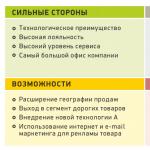· · Fine motor skills: we train fingers - we develop speech! Finger gymnastics: developing the baby's hands
Is it possible to work with a nursing baby or is it worth waiting until he grows up? The answer is unequivocal - it is possible and necessary.
Why do we need dexterous fingers? Perhaps every mother can easily answer this question. First, to cope with a variety of everyday tasks (zip up, unfasten buttons, tie shoelaces, eat with a spoon). Then in order to successfully master the writing of sticks and hooks in a notebook. And later, in order to skillfully hold any necessary tool in his hands and perform even the most delicate work. But it turns out that exercises for the development of fine motor skills are needed for a baby not only for this. Domestic physiologists, in particular V.M.Bekhterev, proved in their works that simple hand movements improve the pronunciation of many sounds, develop the child's speech. This is because the nerve endings on the fingers are directly connected to the speech center of the brain. But finger games don't only affect speech. They have a positive effect on the entire brain as a whole.
But there is another great benefit of finger play and exercise. They have a positive effect on the health of the child! Interestingly, in Japan in preschool institutions a special technique of finger massage is used. And this is no accident! The Japanese believe that massage of each finger stimulates and improves the work of a specific organ, makes better health, has an immunostimulating effect.
So how can we help our little one? How to make his hands and fingers more dexterous, skillful and trained? Let's look for ways!
1-3 months: first massage
Very soon the time will come when your son or daughter will touch the beads on toys with his fingers, fold puzzles and mosaics, sculpt from plasticine and dough, string beads, button up the buttons on his shirt on his own, tie the laces on sneakers, repeat after you all the movements of funny finger nursery rhymes and perform many other such simple and at the same time difficult actions for little fingers. But so far all this is inaccessible to the crumb. He was just born and knows little to do himself. But developing fingers is easy even in a newborn baby! To do this, we will do a simple finger massage to the baby.
You can massage your fingers at any suitable time: when you play with your baby, when you change your clothes, you bathe. And the most convenient way to do massage is while breastfeeding. Everything is very simple here: gently stroke each finger of the child, running your fingers along it in the direction from the palm to the ends. Then gently knead your fingers, giving Special attention their tips. You can bend and unbend the fingers of the crumbs, stroke, knead in circular motions and tickle the palm and the whole brush. The baby's fists are still tightly clenched. Open them carefully by straightening your fingers. The main thing is that such a massage does not cause negative emotions in the baby. You can stretch your fingers several times a day for 2-3 minutes.
3-5 months: first games
At the age of about three months, an important and interesting event occurs in the baby's life: he begins to notice his pens, and a little later he will actively use them! Such progress, of course, must be used by offering the baby the very first games and toys that will make his fingers more dexterous.
Useful toys. Choose lightweight rattles in bright colors for your toddler. When the baby is in good mood, put a rattle for him in the right, then in the left handle. Even if the crumb only holds it for a few seconds, and then drops it, it's okay. He's just learning! Gradually, the rattle will linger in the small fist longer and longer, the baby will examine it, shake it, rattle, try to put it in its mouth. These very first rattle games are very important for the development of baby's motor skills.
Try to select toys so that they are different in volume. Then every time playing with them, the baby will train different types grip: one toy should be grasped with a palm, the other should be taken with only two or three fingers. Different shapes toys are also important, because to hold each of them, you need to open your fingers and turn the brush in different ways. And they will also add variety different materials from which toys and various surface textures are made. Playing with them will become an additional massage for small fingers, they will develop both motor skills and tactile sensitivity.
Make for the kid homemade toy which he will enjoy playing for many months. On strong laces of different lengths, string large buttons, beads, empty wooden spools, knuckles from old accounts, toys made of chocolate eggs (holes must first be drilled into them), etc. so that the whole thing can move easily. Tie the ends of the laces. For safety reasons, you need to fasten the ends very securely so that the baby cannot untie or break the lace. In addition, the resulting "beads" should not be too long so that the child cannot put them on the neck. Such beads can be given to the baby in the arms, hung in the crib and stroller. Fingering different objects with your fingers, the baby will develop motor skills and massage the fingers.
Hand games. At about the same age, you can start playing with your baby in the first games with pens and fingers. Try in every possible way to stimulate the baby's desire to reach for toys, various objects, your face. To do this, bend down so that the baby can reach your face and touch it. Take the baby by the handles and bring it to your face, put your palms on your cheeks. Hang toys in the crib so that the baby can reach out and take them. Put a bright sock or a large bright elastic band on one of the baby's arms. Noticing an unusual object, the baby will try to reach it with his free hand. And grabbing one handle with the other is a very useful skill. Next time, slide the sock over the other handle. And then the time will come for the legs, let the baby try to catch them with the hands. At first, help the baby by pulling the legs to the handles so that he can grab them. In this case, you can sentence the nursery rhyme:
Legs, legs, where have you been?
- We went to visit grandma!
Hey you pens! Good luck, good luck!
Try to catch us!
The baby's arms are still clenched into fists. To help your fingers relax and straighten faster, continue to massage and play simple finger games with your baby. Tell a rhyme and unbend your fingers one by one:
A squirrel is sitting on a cart
She sells nuts:
Little fox sister,
Sparrow, titmouse,
To the fat-headed bear,
Zayinka mustache ...
5-7 months: we continue to develop!
The baby's fingers are already quite developed. Perhaps he even manages to press the buttons, or he is about to learn it ...
Useful toys. For the development of hands, children of this age need toys with a large number of all kinds of rings or large beads that can be fingered with their fingers (rings connected together, rods with rings, etc.). You can please your kid with a whole play center, where there will be many useful finger development tools. Let him feel the details of the toy, move the rings, beads, grab the protruding handles ...
Be sure to offer the baby toys with buttons and keys: developmental panels, a children's piano, etc. Lay the baby on his tummy with a toy in front of him. Press the buttons so that the baby listens to sounds. Then it will try the path itself. At first, he will simply clap his palm on the buttons. Take his finger, press a button or key, and then admire the result: “Well done! Happened!" Gradually, the baby will learn to press the buttons on its own. This will not only entertain him, but will also strengthen his fingers.
You can make toys for developing motor skills and tactile sensitivity yourself. For example, sew several bags from fabrics of different textures and fill them with different fillers (semolina, peas, pasta, buckwheat, etc.). These bags can be hung in the baby's crib or simply given to the baby from time to time in the arms so that he crumples and feels them. You can additionally sew large buttons and beads, empty wooden spools, rosary details, etc. to the bags. It will be interesting for the kid to grab them with his fingers and pull. The main condition: the bags must be securely sewn up, and the buttons must be tightly sewn so that loose small parts do not fall into the baby's hands and then into the mouth.
Finger games. When playing with your baby, be sure to pay attention to finger games. While the baby is small, he will not be able to perform movements on his own. But for him, mom will do it just fine. There are many popular and original finger games. But for now, choose the simplest and shortest of them so that they do not have time to bother the baby. Tell the rhyme clearly, rhythmically and cheerfully and bend and unbend the baby's fingers, trying to evoke an emotional response from the little player.
- Finger-boy, where have you been?
- I went to the forest with this brother.
I cooked cabbage soup with this brother.
With this brother - I ate porridge.
I sang songs with this brother!
This mouse is sitting in a mink,
This mouse is running in the field,
This mouse counts ears
This mouse collects grain,
This little mouse shouts: “Hurray!
Everyone get together, it's time for dinner! "
Another useful exercise for this age is “brushing”. Lift the baby's arms one at a time and run it back and forth over the head, as if the baby were combing his own hair. Exercise strengthens the muscles in the palms and fingers.
7-9 months: grabbing fingers
"Stepping over" in the second half of the year noticeably changes the behavior of the baby. If earlier the baby liked "talking" with his mother more, now his favorite pastime is to grab everything that comes to hand, be it mother's hair or various objects within reach. In addition, the baby already knows how to act with both hands at the same time. These features of the crumbs must be actively used, offering him a variety of toys and non-hazardous household items for play: a comb, boxes, food bowls, lids, clothespins, foam sponges, plastic bottles, etc. Let him grab them, feel them, squeeze them, study them with your fingers.
Useful toys. From about this age, the first pyramid should appear in the baby's toy arsenal. This is a wonderful toy that develops the baby's thinking, and his motor skills, and coordination of movements. But in order for the pyramid to benefit the baby, choose it correctly. The toy should be large, with a thick shaft and large, easy-to-put rings. The kid will be able to cope with such a toy, and, therefore, it will not bore him after half a minute of playing. Toys and play centers where you need to grab, move, rotate, press, touch something are still relevant. For example, a game labyrinth in which colored balls move along curved wires.
Be sure to purchase a few rubber squeaker toys for your baby. For them to make sounds, they need to be squeezed well in your hand. And this is a completely new movement that will strengthen the fingers and the hand. Such a baby expander turns out to be! Toys should not be too "hard", otherwise the baby will not be able to cope with them and will quickly lose interest. The first constructors and cubes consisting of several large parts will come in handy. Have your toddler try to grip the parts with his hand and, under your guidance, stack them one on top of the other.
Finger games. The kid grows up, and finger games begin to give him more and more pleasure. If you haven’t played Crow Magpie with your baby yet, it’s time to give it a try. Despite the seeming simplicity, this is a very useful game for the kid. But for the effect to be more effective, you should not just bend your fingers, but massage them lightly, starting with the little finger and ending with the thumb. We will also "cook" porridge on the palm of your hand quite intensively, kneading your palm in a circular motion. Remember to alternate between right and left sticks. Closer to the year, the baby will learn to perform some of the movements on his own. For example, "cook" porridge with your finger. Everyone probably knows the nursery rhyme about forty. And here is a similar rhyme for a change with the same movements:
Our Masha
Cooked porridge, (we run our finger on the palm)
I cooked porridge
The kids were fed: (bend fingers in turn)
I gave this,
I gave this,
I gave this,
I gave this,
But she didn’t give it to him.
He was naughty a lot.
He broke his plate.
Here is another finger nursery rhyme that you can offer your baby. Squeeze its handle into a cam. While pronouncing the rhyme, unclench your fingers one at a time, and at the end again hide them in a fist.
One, two, three, four, five,
The bunnies went out for a walk.
One, two, three, four, five,
They hid in the house again.
Fun fun. You can develop motor skills even while swimming. Throw small toys and objects (spoons, kinder surprise toys, shells, large pebbles, etc.) on the bottom of the bathroom. Toys that float on the surface are also suitable. They will certainly interest the kid, and he will want to get them. To grab small items, he will have to especially try. After all, grabbing them with your whole palm is not very convenient, it is better to take them with your fingers. This means that the fingers will be able to practice new movements. Show the baby that the caught items can be put in a plastic bowl floating on the water. Teach your toddler to spank open palms on the surface of the water. Of course, this will cause a lot of splashes, but it will massage your palms well, which is very useful.
9-12 months: we can do a lot!
Closer to the year, the baby's skills and thinking are developing with such impetuosity that literally every day a little clever girl presents us with something new. Expand the range of educational toys, offer new games to your baby. This will bring invaluable benefits to its development.
Useful toys. The little fingers are becoming more and more dexterous, just a little more - and they will learn to open a variety of boxes. We need to help them with this! To do this, add to the baby's toy arsenal all sorts of toys that are associated with opening and are inserted one into one. For example, a large nesting doll with a whole team of smaller nesting dolls hiding inside. And also a set of plastic caps that can be inserted into one another or build a high tower out of them. If you have a selection of different sized food pans, they make a great toy too. Let the baby insert them one into the other, trying to remove the covers from them (he will learn how to put on the covers a little later). In order to stimulate the child's desire to remove the lids from the vessels, place a small toy in each. Give the baby a bottle with a screw cap, a jar of cream (for interest, you can also put something in front of the baby's eyes, for example, a cookie) - and let him train in unscrewing and twisting. Several cloth handkerchiefs of different sizes will be no less useful. You can perform a variety of manipulations with them: pick up, cover yourself, your mother, or “hide” a toy, wrap a little doll or car.
At this age, it is already possible to offer the baby large insert frames and all sorts of sorters, where you need to push different parts into the corresponding holes. The choice of such toys is huge.
Finger games. Keep playing your kid's favorite finger games and add new ones of course. For example, about cabbage. If you train actively, closer to the year the baby will learn to perform all the movements on his own.
We chop-chop the cabbage, (alternately we hit the edges of our palms on the surface of the table),
We salt-salt the cabbage, ("salt" with small pinches of the left and right hand)
We are three or three cabbage, (we rub our palms),
We squeeze-squeeze cabbage (squeeze-unclench our left and right hands into fists)
Fun fun. While bathing, run all kinds of containers into the bath: plastic cups, bowls, bottles, spoons. Show your baby how to pour water from one glass to another, how to pour liquid from a small bottle. It doesn’t matter if the water stream doesn’t immediately hit its destination. Everything requires training. Give the child toothbrush and let him run his finger over the stubble. Help him massage each finger in turn.
Useful ideas
There are many activities you can think of to develop your toddler's motor skills without even using expensive, store-bought toys. For example, give crumbs a few sheets of white paper. Let them crumple the paper in their hands, unfold it and crush it again. For the same purpose, a pack of paper napkins is suitable. It's so much fun to tear them apart! And at the same time exercise your fingers. Just do not give your baby magazines and newspapers to be torn apart. If you don't follow it, the paper can get into your mouth. Let it be just white, no ink.
Show your kid how you can throw a variety of small objects into a five-liter plastic bottle: clothespins, small toys, candy wrappers and other pieces of paper, various rags, felt-tip pen caps and felt-tip pens themselves, pebbles, chestnuts ... In a word, everything that fits into the neck. This is a simple but very useful exercise for toddler's fingers. Just do not give the baby too small objects (beans, buttons, beads) and be sure to be nearby during the game!
Now, inspired by these simple ideas, you can certainly come up with many of your own games for training your son or daughter's fingers. Let these games be both fun and useful!
I am glad to welcome you, dear parents!
Finger massage very useful for a small child. No wonder they say that handmade calms the psyche, pacifies, for example, knitting or embroidery, because the fingers of the dough are associated with the activity of the brain. There are many points on the palms and fingers that are responsible for the functioning of various organs in our body. Due to the tone of the pens, up to about 2 years old(some earlier, some later), but it still persists, and the child often squeezes his fingers into a fist.
Such massage of hands and fingers will relieve him of such a clamping, the child will better control his pens and fingers, it will be easier for him to draw, it will be easier to hold a pencil, it will be easier to sculpt. Flexibility and coordination of fingers develops. The familiar to all of us is developing fine motor skills... The child will speak earlier, just remember that classes need to be carried out regularly.
Sometimes, when children are worried, they fiddle with something, be it a toy or some kind of rag. In this case, you should not take these objects away from the child, so he instinctively tries to calm himself down, gets rid of the excessive excitement of the body.
Finger exercises, accompanied by funny rhymes or nursery rhymes, are very popular with children. They are suitable for ages 9 months and older. During such activities, the child learns to listen, to project what he heard on real events and objects, a sense of rhythm is developed. We study the names of the fingers. - Danyusha, show me where is your pen? And then, where is the right pen, where is the left?
At first, when you just start introducing such exercises, the baby can only observe you, without reacting in any way, over time he will get used to the exercises and will help his mother. As soon as the mother begins to pronounce the familiar rhyme, the baby already makes the necessary movements with his fingers. Then, if classes are regular, the child will learn familiar rhymes. First, he will repeat individual words after mom, and then whole lines.
But there is also a reverse reaction, the child cannot be seated in any way in order to do at least one exercise. This was in our case, my son did not want to sit still, and even more so there was something else to do with his fingers, he was attracted by more mobile activities. Then I had to catch him, in order to try to work out at least a minute or two. My persistent efforts were rewarded, and after a month the baby himself handed me pens with spread fingers, thereby showing that it was time to play with them.
If this is your first time starting finger exercises, then start with the first set. It is suitable for children whose handles are tight, fine motor skills are poorly developed. Such introductory course you can start from the first days of life. When you do the first complex, you will feel that the child is ready to move on, proceed to the second. The second can be carried out continuously daily or every other day. 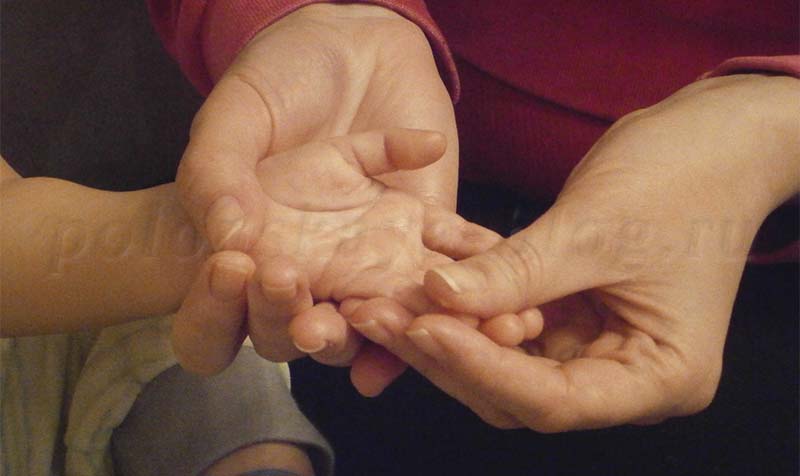
Take the baby's handle with one hand and massage with the other.
Complex number 1
1. Pat the baby's handle several times from the fingertips to the elbow and vice versa. First stroke the outside of your hand, then the inside.
Pens, pens! Do I know you,
I wash you with water.
I know my fingers too
I play with them now.
2. Stroking each finger to the palm. Every finger, every phalanx, from the pad to the base of the fingers, then change the handles.
In girls and boys
There are five fingers on the hand:
A big finger is a guy with a soul,
Index finger - gentleman powerful,
The middle finger is also not the last.
Ring finger - an important one walks with a ring,
The fifth - the little finger, brought you a present.
3. Using a patting motion, slide over each finger from tip to palm. Then change the handles.
This finger is a grandfather
This finger is a grandmother
This finger is a daddy
This finger is mommy
But this finger is me,
That's my whole family!
4. Point circular movements from the fingertips to the palm. Then change the handles.
This finger wants to sleep
This finger went to bed
This finger took a nap
This finger has already fallen asleep
This one is fast asleep
Hush, hush, do not make noise ...
The red sun will rise
A clear morning will come
Birds will chirp
Fingers will get up!
5. Massage the pads, lightly pressing on them, and on the palm of your hand - in a circular motion, like a magpie.
I have five fingers on my hand
Five grippers, five grippers.
To throw and to hold
To take and to give.
Of course, there are five of them!
6. Finish the gymnastics with exercise # 1
Complex number 2
If the child does not yet understand what you want from him, then you can perform the exercises by taking his hands in yours. Some exercises cannot be done yet.
1. Rub your palms together to warm them up.
2. Make a fist, then unclench.
3. Hook the fingers of the same name on one hand with the other and pull slightly to the sides.
4. Make the handles in a lock. And without opening your fingers, move your wrist.
5. "The Suns". Morning has come, the sun has risen (palms with outstretched fingers go up). We keep our palms parallel with clenched fingers, then spread the fingers. - The sun is shining.
6. Fingers greet. Alternately, each finger is in contact with the thumb on each hand.
7. Little people run and then play football. Roll a small ball with your fingers.
8. "Scissors". We simulate scissors with two fingers. As if we are cutting what is at hand - a book, a diaper, etc.
9. Place the pens on the table. And lift each finger alternately.
All the best! Until next time!
1. SunshineStraight-line stroking of the dorsum and palmar surface of the hand with the fingertips are the "rays of the sun".
The sun is stroking us with rays, caressing us.
The sun, like mom, only one thing happens.
2. White-sided magpie
Spiral stroking of the dorsum and palmar surface of the hand with the fingertips.
Forty - forty, where have you been? Far.
She chopped wood, stoked the stove, carried water.
She cooked porridge, fed the children.
3. Blizzards
Zigzag stroking.
Blizzards whistled, snow flew
A big blizzard was making the beds.
And the snowstorms had no time for sleep.
In the morning we looked at the garden - the drifts in the garden are flying like pillows.
4. Snail
Pincer kneading the edge of the palm.
BBW is a creeper, a curl house. Crawl down the path
Crawl on your palm. Crawl, don't hurry, show your horns.
5. Spider
Sawing (longitudinal and transverse) of the palm with your fingers.
A wondrous miracle is a spider. 8 legs and 8 arms.
If you need to run away, help out 8 legs.
Weave the net around the circle, help out 8 hands.
6. Saw
Sawing (longitudinal and transverse) of the palm with the edge of the palm.
She got down to business. She screamed and sang.
Ate, ate, oak, oak, broke a tooth, a tooth.
Active massage (the child independently performs massaging movements)
7. Beasts
Massage of the fingertips. After the fifth line, there is a change of hands.
Children love all animals: (thumb)
Birds and lizards and snakes (index finger)
Pelicans, cranes, (middle finger)
Hippos, sables, (ring finger)
Doves and wood grouses, (pinky)
And crossbills and bullfinches (thumb)
They love the mountain goat, (index finger)
Monkey and donkey, (middle finger)
Porcupine and hedgehog, (ring finger)
Turtle and snake (pinky)
8. Bear
Massage of the fingertips. One finger is kneaded for each line. After 5 lines - change of hands.
The bear was walking towards its den, but stumbled on the threshold.
"It can be seen that I have accumulated very little strength for the winter."
So he thought and went in search of wild bees.
All bears have a sweet tooth, they love to eat honey without haste,
And when they have eaten, they sniffle in the den without anxiety until spring.
9. Vegetable garden
For each stressed syllable, one phalanx is kneaded. After 4 lines - change of hands. The last two lines are kneading the thumbs of each hand.
We have grown garlic,
Pepper, tomato, zucchini,
Pumpkin, cabbage, potatoes,
Onions and a little bit of peas.
We collected vegetables
They treated friends with them,
Fermented, ate, salted,
They were taken home from the dacha.
Goodbye for a year
Our friend is a vegetable garden!
10. Clicks
The palm is pressed to the table, the fingers are spread. The other hand raises the fingers one at a time (the lying hand presses down with force, resisting the rise). Then the finger is released, and it falls abruptly on the table with a thud. One finger is raised for each line. After 5 lines - change of hands.
The chipmunk raised his ears. He heard a sound in the forest:
- What is this loud knock, knock, knock, knock and knock?
- Let's go, - said the badger, you yourself will see this trick:
This woodpecker sat on a branch, and without wings and without arms
He is looking for where the beetle is hidden, so a clatter is heard!
Massage fingers and hands with a massage ball
11. Ball
Roll the ball between the palms:
I will roll in my hands
My ball is good.
To always be healthy
Dexterous and cheerful.
12. Ball
I roll the ball in circles
(roll the ball between palms in a circular motion)
I drive him back and forth,
(we drive the ball between palms on the table)
I will stroke my palm with it,
(stroking one palm with a ball)
As if I sweep away a crumb
(stroking the other palm with a ball)
And I remember him a little,
(squeeze the ball with one hand)
Like a cat squeezes a paw.
(change and squeeze the ball with the other hand)
13. Hedgehog
We will take a hedgehog in our hands,
(take a massage ball)
Let's ride and eat.
(roll between palms)
Throw up and catch
(throw up and catch)
And we will count the needles.
(with the fingers of one hand we press the thorns)
Let's put the hedgehog on the table
(put the ball on the table)
Press the hedgehog handle
(we press the ball with the handle)
And let's ride a little ...
(roll the ball with the handle)
Then we change the handle.
(change the handle and roll the ball too)
We roll the ball or hedgehog from the elbow to the fingers along the inside, saying the words:
A prickly hedgehog is rolling
There is no head or legs
Running on my fingers
And puffs, puffs, puffs.
Runs back and forth
It tickles me, yeah, yeah, yeah!
Go away, prickly hedgehog
Into the dark forest where you live!
15. Ball
Movements are performed according to the text:
This ball is not easy
All prickly, like that.
We put between our palms
We will rub their palms.
We roll it up and down
We develop our pens!
You can roll the ball in a circle
Throw to each other.
1, 2, 3, 4, 5 –
It's time for us to rest!
16. Eccentric hedgehog
Hedgehog, hedgehog - freak
Sewed a spiky jacket
(roll the ball in the palms forward - backward)
I got up in the morning and walk into the forest,
(put your hands up)
To see everyone's friends.
(touch the ball with your fingers, slowly lowering your hands down)
The hedgehog stomped along the path
(knock the ball on the table)
And he carried a mushroom on his back.
(put your hands with the ball behind your head, roll the ball down your neck)
The hedgehog stomped slowly,
(roll the ball forward one knee)
Quiet rustling leaves.
(roll the ball back on the other knee)
And a bunny gallops towards,
Long-eared Bouncy,
(throw up and catch the ball)
Someone's cleverly in the garden
Got a scythe carrot!
(put your hands behind your back and hide the ball)
Massage fingers and hands with a pencil
17. IronTake a thick pencil. Put it on the table. "Iron" the pencil first with one palm, then with the other. Roll your pencil on the table.
I will shake the pencil
Left and right - as I want.
18. Making fire
Place a pencil on one palm, cover it with the other. Roll the pencil between your palms slowly at first, and then faster, from your fingertips to your wrists. Now try to do it with two pencils at once. Happened?
19. Catching up
Take the pencil with all your fingers. Twirl it. Let your fingers run over the pencil, catching up with each other.
Fingers run forward
And nobody is lagging behind.
20. Slide
Place your pencil on the back of your brush. Bend your hand down. Hold the pencil with your other hand. Let it slide down from your hand, like a slide.
21. Spinning Top
Rotate the pencil on the table with two fingers, first with one hand and then with the other. Try doing the same with your thumb and middle finger.
I roll circles around the table
I don't let go of the pencil.
22. Helicopter
Take a thin long pencil with two fingers. Twirl it. Let it rotate fast, fast, like a helicopter propeller.
Takes flight
Our handsome helicopter.
23. Massage with clothespins
Clothespin on stressed syllables verse alternately "bite" the nail phalanges: from the index finger to the little finger and back. After the first couplet - a change of hands. It is necessary to check that the clothespins are not too tight.
The kitten bites strongly - a silly one,
He thinks: this is not a finger, but a mouse.
- But I'm playing with you baby!
- And if you bite - I will tell you "Shoot"!
24. Massage with walnuts
Roll 2 nuts between palms:
I roll my nut
To become the roundest of all.
25. Massage with paper
"Hide and Seek" - clenching paper in a fist. Hide a piece of paper - clamp it in a cam:
I squeeze a piece of paper and change my palm.
The selection was prepared by Natalia Sokolova, a practicing speech therapist
A child's speech is the functional work of many organs. Good physical shape, strong the immune system, a strong heart, good blood circulation and oxygen supply to the brain, the absence of genetic pathologies, love, attention of parents - and your baby will amaze others with early conversational speech. It takes hard work to teach your child to speak on time. Correct pronunciation of sounds, the formation of phrases, a rich vocabulary can only be in a fully developed child. And vice versa, the later the baby begins to speak, the more difficult it will be for speech disorders, and also the lower his level of intelligence, communication skills and emotional stability will be.
There are many incentive methods developed speech in preschoolers, but the earliest and most important of these is finger massage to target the small muscles of the hands. Human fingers and palms are a projection of all internal organs... By massaging your palm, you start the intestines. Squeezing and rubbing the little finger, you improve the work of the heart, the nameless one normalizes the work of the nervous system, the middle one is responsible for the functioning of the liver, the index finger - the stomach. Finally, a thumb massage stimulates the brain and lungs. All games with children under one year old are associated with finger massage, which triggers the rhythmic work of the body, and accelerates the process of the general formation of the baby's body, and in particular, the speech process.
Rubbing hands - the beginning of the formation of crumbs

Fine motor skills are general movements of the small muscles of the fingers, palms, and hands in babies. A child who coordinates the actions of fingers well, develops quickly and begins to talk in a timely manner. He has formed the parts of the brain that are responsible for speech development, he is mobile, active, easily makes contact and is very smart. If you want to have a well-rounded personality, fluent in speech, intellectual, with excellent creative potential, then it's time for you to get fairy tales for children and start massaging the baby's hands. Fairy tales are needed to remember how our parents, grandmothers and great-grandmothers pampered us - after all, finger procedures are many hundreds and even thousands of years old.

For the first day of class, choose a moment when the baby wakes up and stretches. If the kid has not yet learned this procedure, be sure to help him - stretching and twisting the tendons awakens the muscles and improves general motor skills in preschoolers. Show how the cat does it when it wakes up. And when the baby has a smile, turn on your imagination - let the worms crawl on his palm, the little ones fly, the goats jump, and you tell him a wonderful nursery rhyme and massage your fingers. When the baby grows up, he will develop his fingers himself - finger massage during drawing, washing, dressing and other procedures will play an important role in the process of his development. And then there are unforgettable finger theater plays and shadow theater. Massaging your fingers with funny rhymes is the first educational lesson, he is very funny and enjoyable!
Psychologists say that small motor functions are directly related to the work of the nervous, muscular systems, as well as the organs of vision, hearing and respiration. The development of fine motor skills must be constantly monitored at each stage of growing up, checking the correspondence of speech formation, the ability to hold objects, lace up shoes, etc. Parents should not wait three years to understand that the child does not yet speak and cannot draw with a pencil. At each stage, the baby should have his own achievements, and parents need to notice in time the baby's lag in development from their peers.
Along with this, they search and read:
Video: Massaging the pens
We roll the pine cone from the tree, we start talking
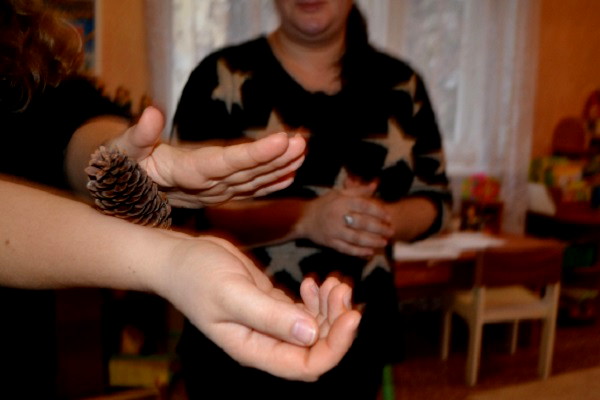
The child grows up and can try a new type of massage for fingers - rolling of natural material, which children really like and is perfect for the formation of developed speech. Games with cones, chestnuts, cereals, beans, sand give children great pleasure. Don't you have it at hand? It doesn't matter, they can be replaced by massage brushes, elastic bands, curlers. Toys with an uneven surface will massage the baby's palms and fingers, bring physical pleasure, and if the game is accompanied by rhymes or songs, the process will be fun and theatrical. By increasing the flexibility and subtlety of finger movements, the baby additionally develops curiosity and imagination, visual and auditory memory, thinking and perseverance. Rolling the bump from the fingers to the wrist, squeezing and rotating it will stimulate blood flow to the hands, increasing muscle tone and strength in the fingers.
In speech therapy practice, the Su-Jok therapy method is successfully used to correct speech delays in children. Exercise machines that massage the pads of fingers and palms and hands - rugs, balls, cylinders with soft needles - are very popular with children and are used as a massage to enhance fine motor skills of the hands and develop speech.
Starting to independently perform exercises that develop fine motor skills of the hands, children at first experience difficulties. The child gains knowledge and skills in the game. Do not forget to make sure that the activities for the baby do not bring negative emotions, turn the difficulties into funny laughter, repeat the exercises or postpone them for a more favorable period. The main thing is not to give up and remember that the baby's hands are a tool for speech improvement, as well as the formation of intelligence, creativity, attention. Daily practice of massaging hands for a few minutes creates a fertile ground for children to develop speech and successful educational process at school.
Creative massage to shape speech
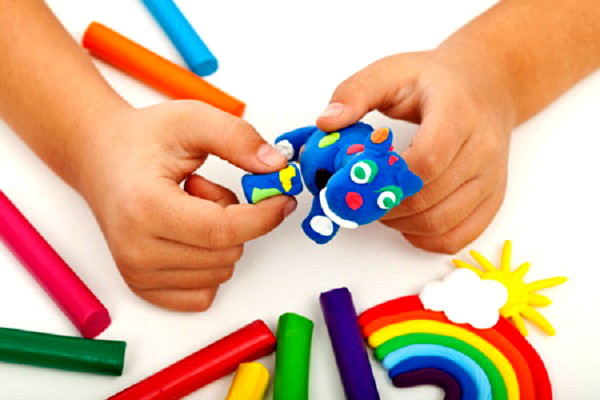
Is your child creative and you want to incorporate them into the parenting process? Try plasticineography - a great tool for engaging your child in artistic creativity and, at the same time, massaging the fingers to develop speech. Working with plasticine enhances the flexibility of the fingers in babies, the strength of the small muscles of the fingers and hands, and prepares the baby to work with writing instruments. If you don't like plasticine - there are finger paints, it's so fun and great! You can keep the baby's masterpieces and donate them for adulthood.
Sand painting on glass is also very popular today. By immersing fingers in loose sand, the baby stabilizes the emotional state, accelerates the figurative and logical thinking... Picking up wonderful material in the palm of his hand, receiving a portion of pleasure, the little wise guy does not easily form his speech skills, he speeds them up many times. The tactile sensations from communication with sand stimulate speech development, thinking and creative activity of young artists.
Influence of massaging fingers on speech formation in babies
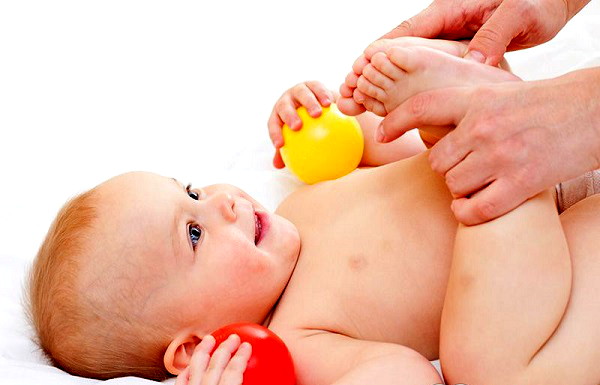
Massage is one of the most ancient methods of human healing, affecting the development of all organs and functions of the body. Its health-improving and preventive effect is undeniably recognized by doctors, teachers and parents. Massaging the fingers leads to unique results in accelerating the formation of children and correcting its delays.
Mechanical irritation of skin receptors leads to the activation of important organs and systems. Hand massage is of great importance for the development of speech, and also actively acts on nervous system, enhances the movement of lymph. This is necessary to improve the immunity of children, has a beneficial effect on the emotional component of the psyche of babies.
Massaging the fingers relieves the baby's stress and improves adaptation in a new environment, develops creativity and reveals new talents, accelerates speech development. And we must not forget about such important components of the procedure as attention and love. They allow you to establish not only tactile contact, but also emotional. The dialogue between parent and baby is one of the most touching and important reasons for his growth and further success in life.
Many parents know how important it is to develop the motor skills of the baby's arms. Science emphasizes the connection between the development of a child's speech and how the fingers of his hands are developed. That is why in Japan, kids are often sent to learn to play the violin from an early age. We offer mothers and their children to do finger gymnastics together - one of the most interesting ways to work together with children in a playful shape.
The goal of finger gymnastics
"Good to know. A set of exercises for the development of hands and fingers is called finger gymnastics. Such gymnastics has a beneficial effect on the baby's body, activating the development of his mental abilities. "
Unfortunately, technological progress, which resulted in an abundance of all kinds of toys, household and computer equipment, is not particularly conducive to children's fingers getting necessary development... Here will come to the rescue finger gymnastics... The games and their components are aimed at developing dexterity, mobility, creativity, attention and reaction speed of the child, and funny poems will help you relax and achieve a calm and peaceful state.
Children with whom they are constantly engaged in finger gymnastics begin to speak earlier and do it better than their peers, learn writing skills faster, remember well, and get less nervous.
Finger gymnastics- a great activity with a child for every day. Teachers and speech therapists use this kind of gymnastics as a teaching tool, a short break between classes and rest for the child. Finger games will be a wonderful part of the content of children's parties.
So, finger gymnastics:
- develops fine motor skills of children's hands and fingers
- promotes the development of the child's brain and speech
- develops creativity
- improves memory
- prepares hand for writing
- cheers up and has a beneficial effect on the psyche of the child
- provides good leisure
- reinforces a positive attitude towards classes.
Development of fine motor skills
Not all parents realize how important it is to work on the fine motor skills of the child's hands, and even more so, not everyone knows how to do this. Let's take a closer look at this issue.
Fine motor skills is the ability to make small and precise movements with the hands (fingers, hands). The sphere of fine motor skills consists of a considerable number of different ones - from simple (grab something, hold something) to complex (writing technique, drawing).
It is extremely important to develop fine motor skills in babies, because it contributes to the full development of the child. You need to start doing this as early as possible. At first Small child sees his hands, examines them, makes movements, tries to control them. Later, the baby tries to take objects on his own, hold them - first with his palm, and then with two fingers. As the child develops, he is shown how to correctly hold a spoon or pencil.
“The formation of fine motor skills is closely connected with the formation of mental cognitive processes of the baby (memory, sensation, perception, attention, imagination, thinking), as well as with the development of speech. Science has proven that the speech and motor centers of the brain are close to each other - which is why stimulating the nerve endings that are at the fingertips helps to activate speech development».
Thanks to the development of fine motor skills, the child develops manual dexterity, beautiful handwriting and quick reactions. By the way fine motor skills are developed, the readiness of a preschooler for school is determined. If fine motor skills are well developed, it means that the child has everything in order with memory, thinking, logic.
Fine motor skills are developed in stages. To do this, the baby needs to select methods and means of development that are appropriate for his age and skills:
- From 6 months. You can start training children's fingers from the moment the baby reaches six months of age - in the form of massage and passive movements.
- From 9 months. Provide your baby with all kinds of cubes, pyramids and rings so that he can sort through them.
- Preschool age. Suggest different types of hand activities: working with constructors and mosaics, drawing, modeling, handicrafts (embroidery, macrame).
Ways to develop fine motor skills

- Finger massage. Such passive gymnastics is suitable for the smallest.
- Finger games. This includes finger gymnastics, finger massage, and finger painting.
- It can be in the form of a tabletop and a horse.
- Games with small objects. You can play with cereals, pasta, sand and other natural materials. Playing with a ball and small toys, as well as classes in making patterns from small parts, help to develop hands well.
- Hand trainers. Toys from the store can also be useful if these are special developmental "simulators": inserts, lacing, etc. Similar ones can be made by ourselves.
- Fine arts classes. Modeling, drawing, applique work, working with a designer - are traditionally considered in great ways development of the child's hands.
- Using a simple pencil. Having received a simple pencil, the baby can train his hands by tracing objects in points and drawing in cells, looking for a way out of mazes, shading silhouettes.
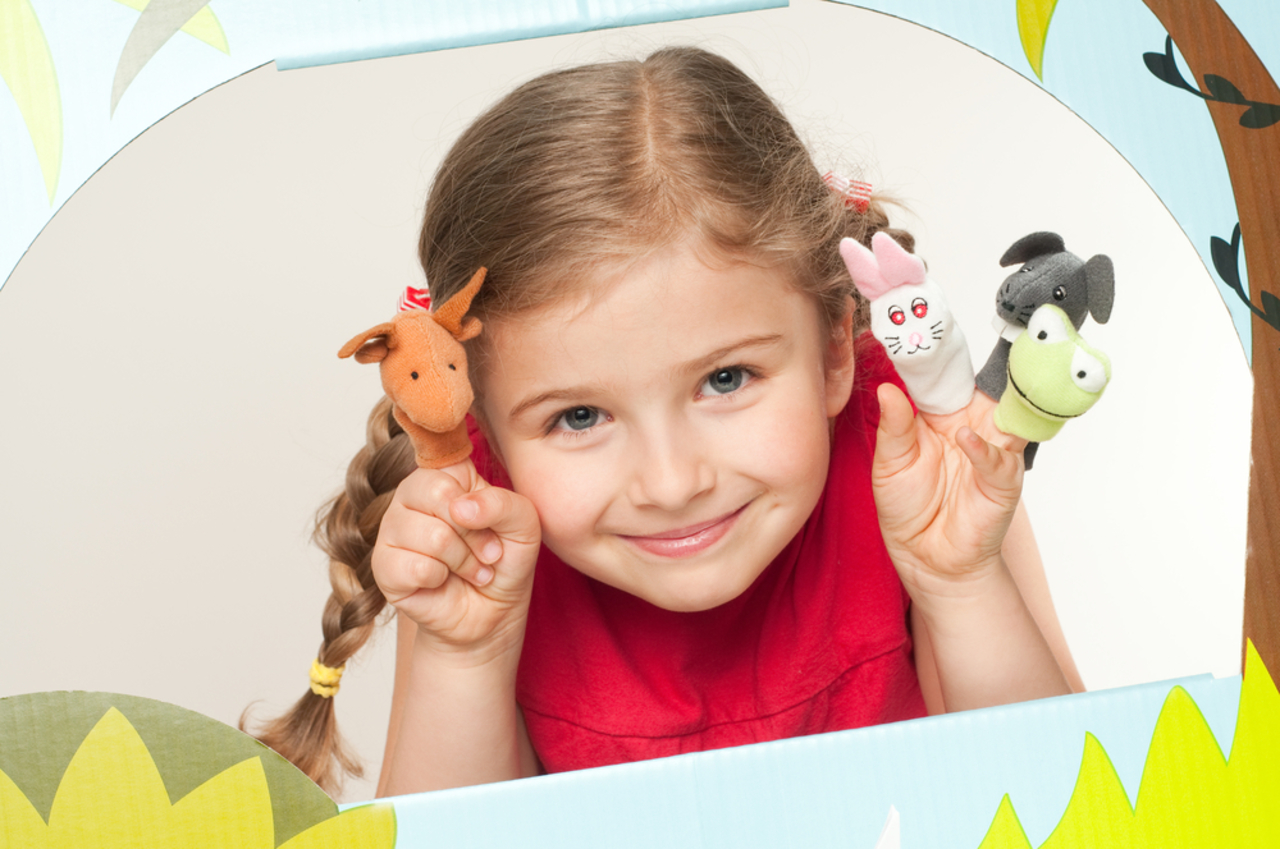
The most effective view lesson is finger training, which includes various games and exercises.
Finger massage
You can start developing your baby's arms at birth. Your toddler will begin to show his willingness to practice by squeezing your finger or trying to grab the rattle. Have you seen how children grab themselves by the legs and pull them to themselves? It is at this moment that the baby can begin to develop pens. A special massage - finger massage will help in this.
Where to begin? Gently bend your little fingers, accompanying the movements with nursery rhymes or funny rhymes. To make the massage more effective, do not just bend your fingers, but massage them lightly - from the little finger to thumb... Talking about how "magpie cooked porridge", "cook" on a child's palm, making circular movements, with medium intensity... At the same time, repeat the rhymes rhythmically, emotionally, expressively, clearly articulating: the baby must understand what it is about. Watch your timbre and intonation. Pay attention to both palms. For the sound accompaniment of such a massage, folk games are perfect, which are played by whole generations of mothers with children: "Ladushki", "Koza-Dereza", "Magpie" others. In principle, any poem or song can become the basis for finger massage. Thus, you will not only be able to start developing the baby's palms, but also have fun.
Finger games
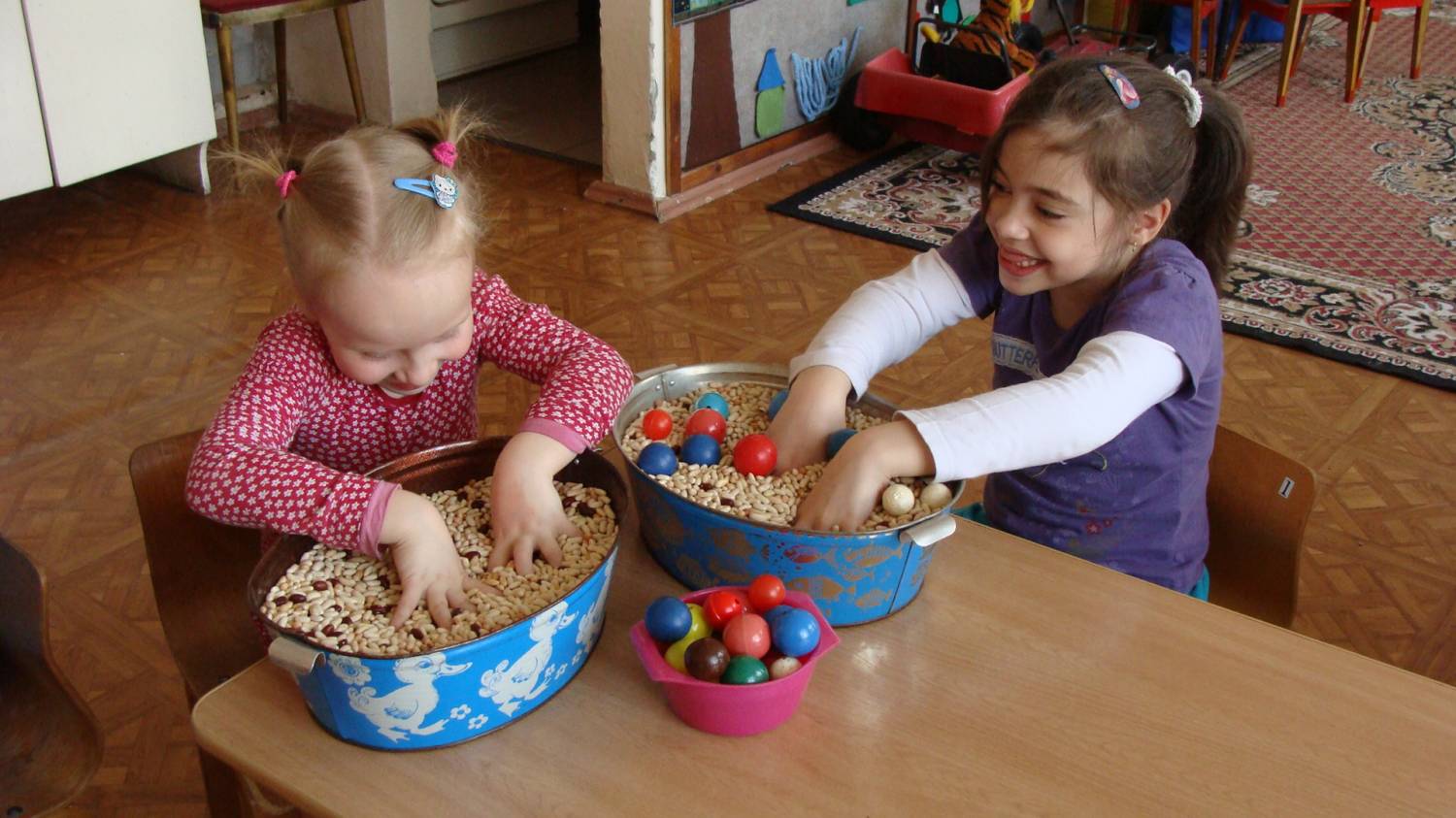
Finger games are useful for children preschool age kind of gymnastics. These games are recommended for one-year-olds and older.
Finger games are very popular with children, develop their hands, strengthen relationships between mothers and children.
Show your child how to play: prepare funny poems, show the movements, and you will see: the kid will be delighted. Finger games also have a learning function: with their help, children learn numbers, learn to count, study body parts, etc.
We list the most effective finger games, which are quite simple to carry out:
- "Okay". We remember the nursery rhyme familiar from childhood and teach the baby to clap.
- "We tear the paper." This can be done at 7-8 months. Show your baby a few sheets. Let him take them, examine them, try to crush or tear them apart. The kid will be interested in new manipulations. He will feel the properties of his hands and various objects.
- "Turning the pages." Flipping over a colorful children's book or magazine is not only an exciting activity for the kid, but also useful for the development of hands.
- "Studying the beads." Toddlers really like to sort out small items. This is also very useful for pens. Allow the little one to sort out his beads.
- "We sort out the cereals." Fill a bowl with cereals and slide it towards your baby. Let him dip his hands in there, touch which grains to touch, pour from palm to palm. This game perfectly develops sensorimotor skills.
- "Patterns in the Sand". Put the sand on a tray. Show your child how to make patterns with your finger. Take your baby's finger and move it along the sand. Start simple - drawing lines, geometric shapes, waves. Gradually complicate the tasks.
- "Covers". A simple household game like twisting the caps on cans and bottles makes your fingers dexterous.
- "We dress and put on our shoes ourselves." This is not a game at all, but the child's usual inclusion in independent activity. Let him learn to button and unfasten buttons, zippers, and tie shoelaces. This will not only help to develop fingers faster, but will also teach the baby to self-serve. In addition, you can make didactic material with buttons and laces, which will be an excellent trainer.
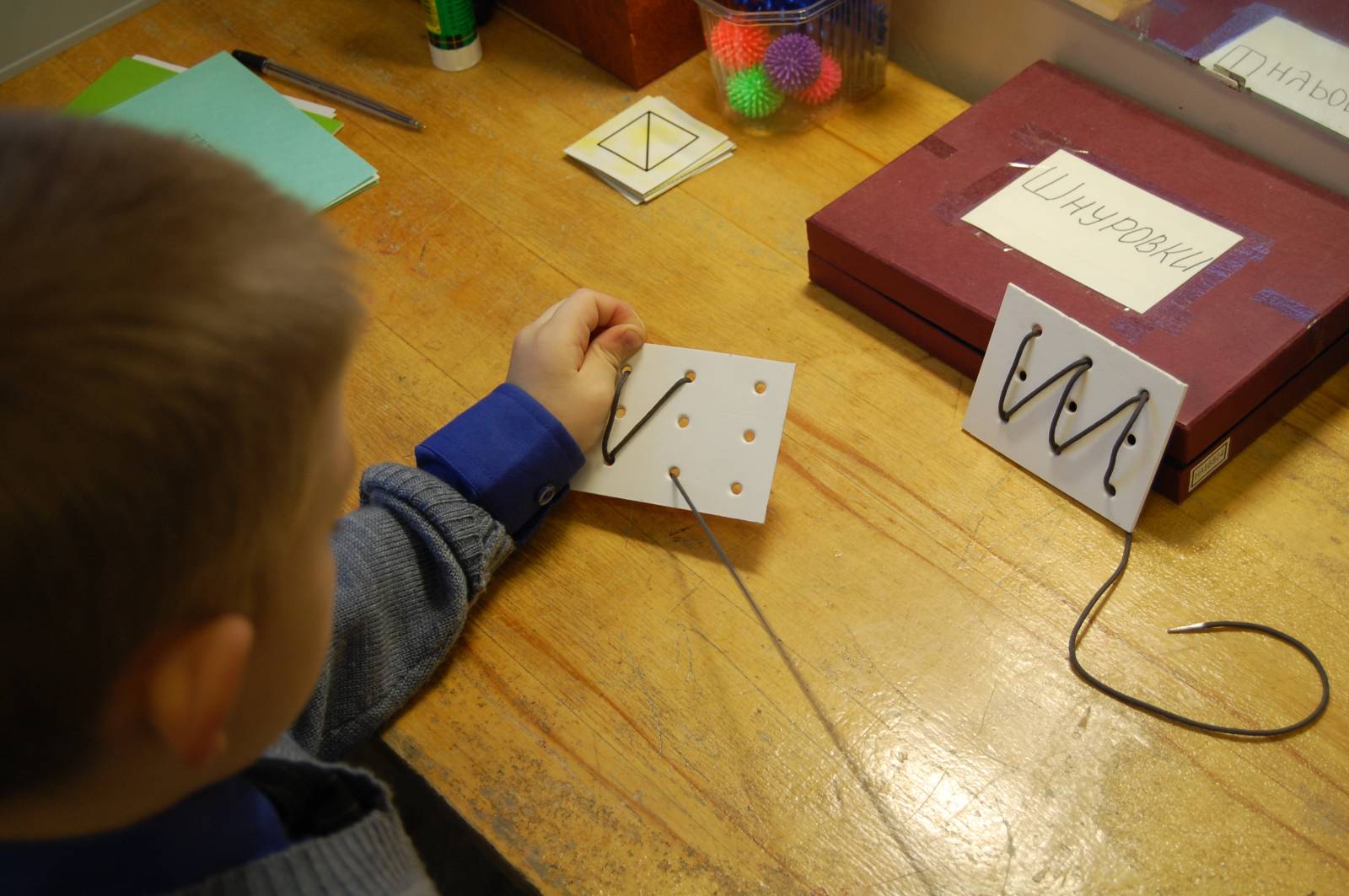
Advice to parents.
- Games must be safe. They must be supervised by parents.
- You need to play regularly. Better to do it daily.
- Don't tire your child. Monitor your child's interest in the game, do not make the activities too long.
Influence on the development of speech
“Has your child already started talking?”, “What was his first word?”: A young mother can often hear these questions. Such questions are not always pleasing, especially if the baby is still. If such a problem occurs, then special attention should be paid to performing finger gymnastics.
Child psychologists have long linked the development of speech and fine motor skills of the hands.
What is the effect of hand development on speech?
The level of motor development of the hands and fingers is directly related to the function of speech. Many scientists studying the activity of the brain of children and their psyche point to the enormous importance of hands, their stimulating effect. Scientists have found that if the fingers are developed in accordance with age, then speech is also normal. If the development of the hands lags behind the norm, then a delay in speech development can be observed in the child. The development of speech occurs under the influence of impulses that come from the fingers and enter the center of the brain responsible for the speech sphere. These data provided the basis for the use of various stimulating methods for the development of speech through the development of hand movements. Massage, exercises, games, manipulating objects, handicrafts, playing musical instruments - all this improves the hands and fingers of the child, contributing to the development of speech.
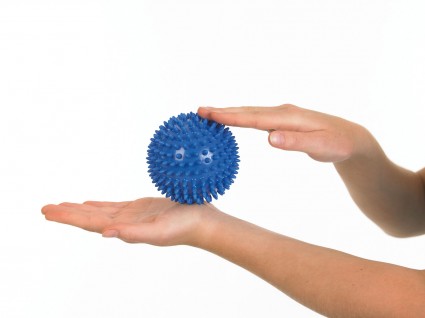
"Advice. Choose exercises according to the age of the child. Massage is suitable for babies. Younger preschoolers - rolling balls of different diameters. For older children - construction, logic games with the use of counting sticks, creating handicrafts. "
Preparing your hand for writing
Both moms and dads and teachers are concerned about the question of how to prepare the child well for school. Educators have noticed that first graders have difficulty mastering their first writing skills. - a fairly difficult skill for a child, based on subtle hand movements. Only well-coordinated work of the small muscles of the hand, developed visual perception and voluntary attention will contribute to success in mastering the writing technique.
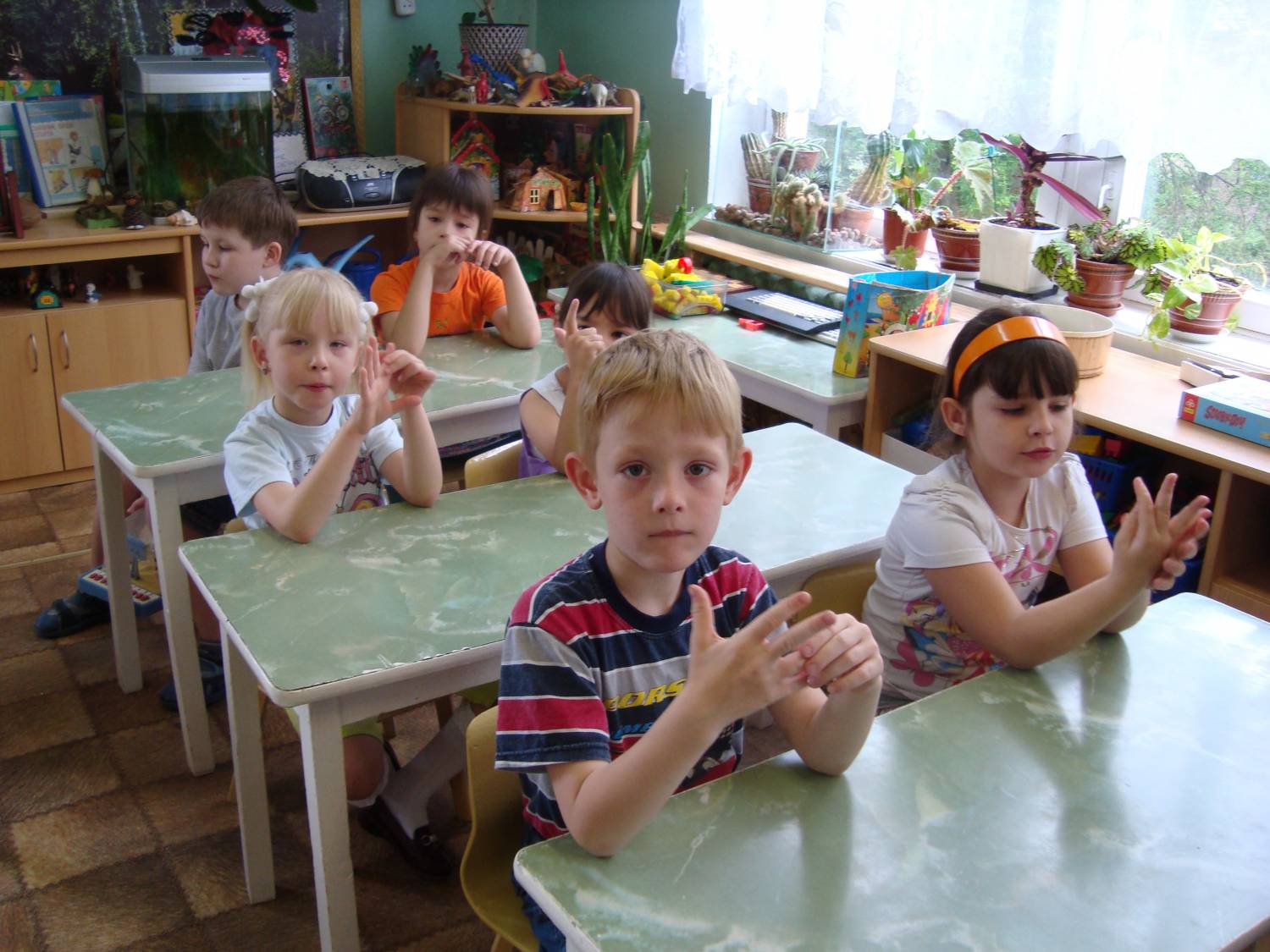
Teachers are often faced with the fact that first-graders cannot hold the pen correctly, they use it incorrectly. The reason for this is insufficient hand development. In this case, you need to turn to finger gymnastics again: simple exercises will help to ensure that the child's hand is properly prepared for writing.
- We massage our fingers. This can be done by the child himself or with the help of an adult. It is necessary to massage the fingers of each hand thoroughly, starting from the tips. This should be done with stroking, rubbing and circular movements. The duration of such a massage is no more than 2 minutes. Finger massage is recommended for writing activities: before the beginning, in the middle, at the end.
- "Greetings". The child touches everyone else with his thumb, as if saying hello: "Hello!"
- "Swan". The child makes movements with his hands, imitating the flight of a swan.
- "Tic-tac-toe". The child alternately crosses the index and middle fingers, ring and little fingers.
- "Bell". The child jogs with his hands for 30-40 seconds.
- "Snake". The child reaches with each finger to the base of the same finger. ...
- "Piano". The child is playing the piano.
- "Cut with scissors." The child connects his fingers in pairs, and then spreads them.
- "Drawing circles." The child draws circles in the air with each finger of each hand.
- At the end of the lesson we repeat exercises # 3 and # 5. We finish with a massage (self-massage).
conclusions
Paying attention to the development of your child's hands, remember that you provide his mental development, improve speech, and provide preparation for school. Such a baby will be developed in accordance with age, schooling it will be easy for him.



